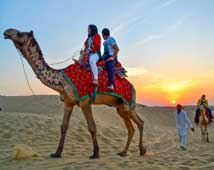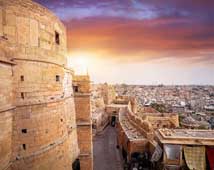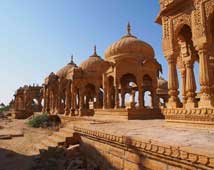
Jaisalmer stands tall in the desolate beauty of the desert, proudly welcoming visitors to an enchanting world of fable, color, and history. The view of Jaisalmer Fort, first seen from a distance of 15 km is stunning. In the early morning the ramparts, bastions and the long stretching walls dazzle gloriously. The yellow sandstone fortifications look magnificent.
It is one of the most exotic cities of the Orient, standing in the heart of the desert for centuries, weathering with fortitude the vicissitudes of fortune and furious onslaughts of nature. The sudden emergence of the 76-meter high rock in the flat desert country crowned by the most awe-inspiring fort makes a majestic sight.
Today, Jaisalmer is the personification of the old order influence the new. An inherent feel for color and design percolated ever stratum of society, and jewelry, crafts and architecture became objects of delight equally between prince and peasant.

Jaisalmer Fort
Jaisalmer fort is the second oldest in Rajasthan after Chittor and commands the desertscape from its 250 feet high perch on the hill. Three strong walls protect the citadel. The first buttress wall was constructed by the local Jain panchayat in the 15th century. Subsequent additions and fortifications were built by the Rawals. The steep cobblestone pathway leading to the royal palace passes through four gates-Akhai Pole (Ganesh Pole), Suraj Pole, Bhuta Pole and Hawa Pole. Sharp turns on the road topped by high defense gateways made it invincible. At the highest point of the place can be seen an umbrella-Meghadamber symbolic of Krishna.
Jain Temples
Within the fort are the three most exquisitely sculptured Jain temples dedicated to Rishabhdevji, Sambhavanathji and the Ashthapadi temple. Their ornamentation done in the style of the Dilwara temples at Mt. Abu is simply marvelous. The emerald icon of Mahavira is an unparalleled gem.
Salem Singh Haveli
It is at an unhurried pace that the havelis (houses of rich merchants) should be seen and admired. These havelis are the pride of Jaisalmer architecture, a part of the national heritage. Salem Singh haveli, at the eastern end of the city, is an Arabian Nights structure, which, like a wild flower, blossoms at the top.
Patwon ki Haveli
Near the city center is the Patwon ki Haveli, built by Guman Chand Patwa and his five sons, dealers in brocade, gold and silver embroidery with business stretching between Afghanistan and China. The five suites built between 1800 and 1860 are virtually the showpiece of Jaisalmer's legendary architectural wealth. The carving on stone far surpasses in beauty the work on brocade and gold. The balconies are so delicately chiseled you would stand mesmerized by the splendor of it all, particularly when viewed early in the morning or in late afternoon. Oblique sunrays create enchanting and dramatic shadows, highlighting the carving and infusing a new life of its own. It is the grandest mansion in Jaisalmer, a veritable museum piece in the open.

Nathmal Haveli
The third haveli belongs to Nathmal, a later day prime minister who gifted it to the Rawal and was allowed to retain it. Built by two brothers in 1885, this haveli has two identical looking portions, which are in fact two different parts united by a common façade. Look for the projected balconies wh9ch seem to emerge from books of poetry. So ethereal, so charming. The carving never looked better. A perfect example of jeweler's art applied to stone carving. The Muslim silavats (artisans) did a wonderful job here and left a marvelous legacy of craftsmanship excellent in detail and flawless in conception. If only for viewing these havelis a trip to Jaisalmer is more than amply rewarded.